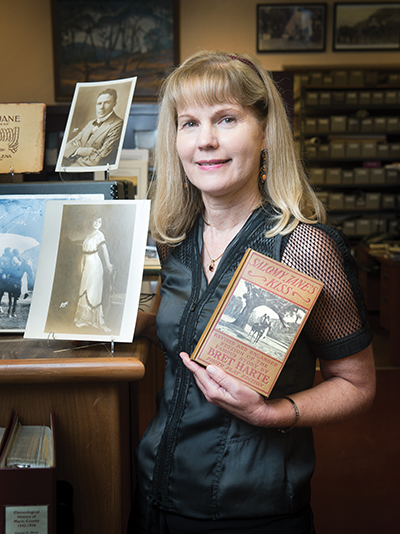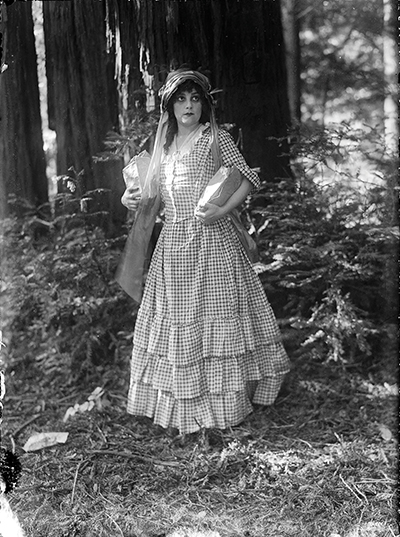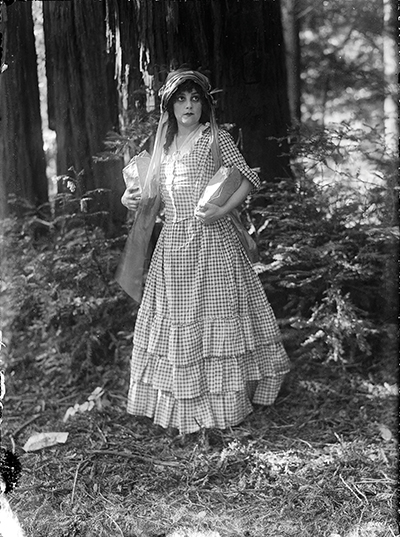
tim porter
Laurie Thompson.
Laurie Thompson remembers the feeling that overwhelmed her when she first learned of the 1914 silent film Salomy Jane. Thompson, a librarian at the Marin County Civic Center public library and a dedicated historian of the North Bay, needed to see the film.
“My mentor Bill Sager, the longtime archivist for the Fairfax Historical Society, told me about this wonderful Western film that was made in 1914,” she says. “It was filmed right here in Marin County before so much of the area was developed.”
Thompson was even more intrigued when she learned that Salomy Jane was long believed to be a lost artifact of the silent film era, and a copy had only been recently rediscovered in Australia and immediately sent to the U.S. Library of Congress.
When Thompson sat down to watch the movie, it did not disappoint. “When I finally saw it, I was taken not only with the film itself but with how Marin County and the beauty of California were highlighted.”
Salomy Jane was the most successful picture from the California Motion Picture Corporation (CMPC), an ambitious production company that set up shop in San Rafael in 1913, building a state-of-the-art studio on a 10-acre lot in what is now the Sun Valley neighborhood.
“The founders of the California Motion Picture Corporation had a strong vision to produce films that would celebrate the history of California,” Thompson says. “They wanted to show things that were unique to the state that people in other parts of the world would have only read about, such as beautiful, giant redwood trees.”
A Star Is Born
In 1914, CMPC produced three films: the comedy Mrs. Wiggs of the Cabbage Patch, a documentary about the Pageant of San Francisco, and Salomy Jane, an epic Western based on a popular Bret Harte novel set during the California Gold Rush.
The latter movie starred Beatriz Michelena, a stage and vaudeville actress and the daughter of a famous opera singer. Michelena would become the studio’s main attraction; her husband, George Middleton, was one of the principal investors in the CMPC and also the director of many of the studio’s films.
Salomy Jane was a major critical success for the fledgling studio, receiving rave reviews and worldwide distribution. Charles R. Condon’s November 14, 1914, review in Motography called Salomy Jane a masterpiece and mentioned that it achieved the CMPC’s goal of showcasing the natural beauty of Northern California.
“There is not a dull moment in its entire six reels,” Condon wrote. “The exterior scenery is unsurpassable: gigantic redwoods, beside which a horse appears no larger than a dog.”
The narrative of Salomy Jane is a romantic adventure, featuring Michelena’s title character and a cowboy played by Hollywood hunk House Peters.
“It’s the story of a beautiful young woman, who is saved from a ruffian by a heroic stranger,” Thompson says. “Later, she comes back and saves the stranger from a lynch mob. And of course, they fall in love.”
While the story may seem like standard melodrama, the filmmaking craft is extraordinary. “There’s no doubt that Salomy Jane is a great action film,” says Thompson. “There is a remarkable stagecoach chase scene, with the coach coming down Fairfax-Bolinas Road. The road at that time was unpaved, the area undeveloped. The chase is very fast-moving, and the camera work is wonderful, especially when you consider the size and weight of film cameras of that period.”
Local Connections

ANNE T. KENT CALIFORNIA ROOM, MARIN COUNTY FREE LIBRARY
Thompson has studied the film repeatedly, trying to spot locations around Marin County. The studio constructed an elaborate set for Hangtown, where Salomy Jane takes place.
“The set for Hangtown was built in the Lagunitas area of Marin County, somewhere between the town and Samuel P. Taylor park,” she says.
Thompson has also tried to find the San Rafael home of Michelena and Middleton, who were the toast of the town in the years following Salomy Jane’s success. “They lived in the west end of San Rafael,” she says. “I would love to discover exactly which house was theirs. I have pictures of Beatriz on the deck of the house, pruning roses.”
Michelena was as glamorous off screen as she was on. “She wrote a column for starstruck girls in the Marin Independent Journal,” Thompson says. “She would walk around town with a Russian wolfhound.”
In the years following the international success of Salomy Jane, the California Motion Picture Corporation began to struggle, while the studio’s extravagances — including construction of an enormous interior stage with glass walls to capture natural light — brought on bankruptcy within a decade. The studio shut down in the early 1920s and kept all its prints in a vault on property. In 1931, a fire burned the studio to the ground. The blaze, possibly started by children playing with fireworks, ignited the highly flammable nitrate prints and destroyed the company’s inventory.
For more than 60 years, film historians mourned the loss of the California Motion Picture Corporation’s cinematic treasures. And then the six-reel print of Salomy Jane was discovered in Australia.
When Thompson requested the print of Salomy Jane from the Library of Congress, she made sure she wasn’t the only Marin County resident to enjoy the film. Thompson has organized two screenings of the film at the Rafael Film Center. Both events sold out, and audiences were treated to Salomy Jane as it was originally intended to be presented: projected on a giant screen and accompanied by a live piano score.
Thompson was rewarded for bringing the film to a 21st-century audience.
“After showing the film the first time, a true treasure came to me,” says Thompson. “A descendant of George Middleton contacted me and said, ‘I have George Middleton’s personal collection. Would you like it?’ I felt like I won the lottery!”
A Treasure Trove
Middleton’s relative gave Thompson hundreds of still photographs from all of the films that Middleton and Michelena shot in San Rafael as well as a bounty of personal photos of the couple. Thompson plans to continue her research about their films, with hopes that more treasures will be uncovered.
At the very least, she believes Michelena and Middleton would be thrilled that there is still interest in their cinematic legacy, more than a century after Salomy Jane was produced.
“They made their mark worldwide, and much of their legacy they created right here in Marin,” says Thompson.


